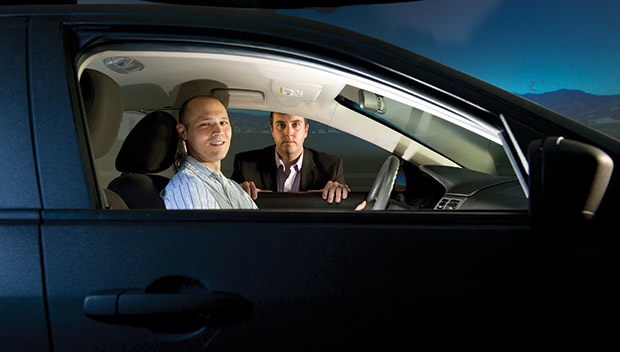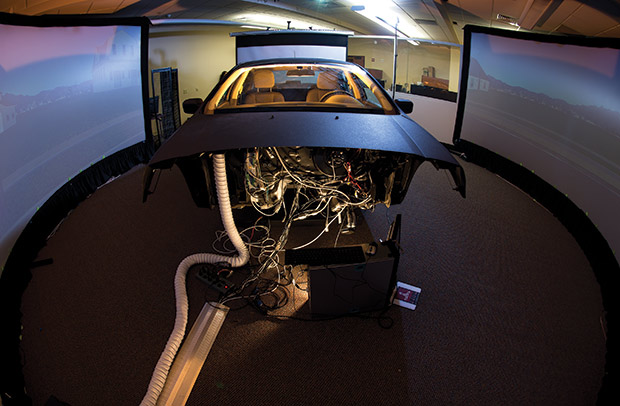Challenges ahead for attorneys as vehicle technology develops
By: Erika Strebel, [email protected]//May 25, 2018//
Challenges ahead for attorneys as vehicle technology develops
By: Erika Strebel, [email protected]//May 25, 2018//

On May 11, a woman driving a Tesla Model S in Utah slammed into a stopped truck while going 60 miles per hour. She’d taken her hands off the wheel and was using the car’s adaptive braking and cruise control, which Tesla markets as “Autopilot.”
That was only one of three crashes involving a semi-autonomous Tesla in May alone.
Earlier in the year, a pedestrian died in Tempe, Arizona, after an Uber car hit her while it was in self-driving mode. The car’s back-up human operator looked up too late to prevent the collision.
Although the end goal of autonomous-vehicle technology is to make travel safer by taking drivers completely out of the equation, experts say crashes like these will become more common for at least the next two decades. The resulting questions will provide legal professionals not only with plenty of work, but also with an opportunity to shape how driverless cars fit into the legal landscape.
As semi-autonomous vehicles start coming to market, they will be sharing the road more and more with ordinary cars operated by human drivers. The day is not long off when a case involving a semi-autonomous vehicle is filed in Wisconsin court.
“This is where lawyers should be concerned,” said Jon Riehl, a transportation systems engineer with the College of Engineering at the University of Wisconsin-Madison. “These crashes like Uber and Tesla are having are going to be more frequent. And that’s going to be what they’re dealing with.”
Madison attorney Brian Jelinek agreed, saying the prospect of drivers and semi-autonomous vehicles having to share some responsibility presents an extraordinary technical problem that will be the subject of much litigation.
Jelinek is a former electrical engineer and patent agent whose work centers on disruptive technologies such as autonomous vehicles.
“Successful attorneys will have a deep understanding of the technology to trace liability to its source and attribute it among parties,” said Jelinek.
However, the personal-injury attorney Jason Abraham of Milwaukee-based Hupy and Abraham questions whether car manufacturers such as Tesla will be willing to give up data so lawyers can gain a deep understanding of the technology.
“You’ve got a huge issue of: When these things come to market, how do we really know if they’re safe or whether they could have been safer?” Abraham said. “Is the governing body that’s overseeing all of this, will they get enough data from manufacturers to make sure that their testing is done right and make sure they’re as safe as they need to be?”

Who’s at fault?
Riehl, who also helps run the University of Wisconsin-Madison’s autonomous-vehicle testing grounds, says that in the next decade or two, lawyers and judges will have a central role in shaping the answer to one important question: Who is legally responsible in crashes involving either semi-autonomous or fully autonomous vehicles?
Riehl is looking for legal professionals from Wisconsin who can tackle that question head-on. He said officials at the UW System’s testing grounds have been working with sociologists as well as teams studying safety but have not yet found a partner to study the legal side of the developing technology.
“The legal answer of ‘Who’s at fault?’ is going to determine whether this continues as more ‘Wild Wild West’ or if we actually start to focus more efforts on this research and how does this get handled legally,” Riehl said.
Shifting risk and product liability
Another issue that will be hammered out over the next two decades is whether car manufacturers are doing enough to tell buyers about the capabilities of their semi-autonomous vehicles. Jelinek and Riehl, for instance, question whether certain marketing tactics — such as when Tesla calls its adaptive-braking and cruise-control system “Autopilot” — encourages people to rely too greatly on the technology.
“The consumer is busy,” Jelinek said. “Their sum total of knowledge is limited by the Car and Driver magazine that they pick up at the grocery store and think, ‘This is really cool.’ They’re led to believe something that isn’t as nuanced as what the engineer knows.”
These sorts of questions about marketing show in one way how liability is likely to shift to manufacturers, and car-crash cases are likely to become more about products liability than negligence.
More specifically, manufacturers may be more vulnerable to claims of product defects or defective warnings, said Allen Schlinsog, a commercial litigator and products-liability defense lawyer at Milwaukee-based Reinhart Boerner Van Deuren.
“From a tort liability perspective, all the manufacturers are going to have to do their best to make sure that they are training the retailers, the drivers — everybody — about not just the benefits of the system but the limitations of it to make sure whatever remaining hazards are open and obvious to the driver,” he said.
Jelinek said many leading law firms are already starting to position their commercial-litigation practices to take on the sorts of cases that will become more common when risk moves to manufacturers. Milwaukee-based Godfrey & Kahn recently held a seminar on autonomous vehicle technology.
Car manufacturers aren’t just accepting that risk, Schlinsog noted. They’re passing it on.
“I think they’re absolving the occupant from any responsibility,” he said. “You can bet whoever supplied the software or the component is going to have to indemnify the OEM for anything that went wrong with it.”
Preparing for a driverless future
New products liability cases probably won’t make up for the loss of a large number of negligence cases.
In 2017, more than 60 percent of personal-injury lawsuits filed in Wisconsin involved car crashes. In comparison, just 41 products-liability lawsuits were filed, making up less than 1 percent of the total personal-injury suits filed.
One reason for that downward spiral is the increasing cost of bringing a product-liability lawsuit. Abraham noted that it’s not uncommon to spend at least $500,000 or more to take such a case to trial.
“It will be interesting to see how this shakes itself out because it will have to be a little different, I believe,” he said. “It will be a suit against the manufacturer but there will have been so many suits against the manufacturer for this kind of stuff that it won’t be traditionally a product liability case.”
Abraham acknowledged that once fully autonomous vehicles become adopted, many personal-injury lawyers will be losing their bread-and-butter work.
“I think there’ll be less accidents,” he said. “Then, I’ll have less clients. But at the end of the day, I think that’s a good thing because everything will be safer for all of us.”
Legal News
- Wisconsin attorney loses law license, ordered to pay $16K fine
- Former Wisconsin police officer charged with 5 bestiality felony counts
- Judge reject’s Trump’s bid for a new trial in $83.3 million E. Jean Carroll defamation case
- Dozens of deaths reveal risks of injecting sedatives into people restrained by police
- The Latest: Supreme Court arguments conclude in Trump immunity case
- Net neutrality restored as FCC votes to regulate internet providers
- Wisconsin Attorney General asks Congress to expand reproductive health services
- Attorney General Kaul releases update at three-year anniversary of clergy and faith leader abuse initiative
- State Bar leaders remain deeply divided over special purpose trust
- Former Wisconsin college chancellor fired over porn career is fighting to keep his faculty post
- Pecker says he pledged to be Trump campaign’s ‘eyes and ears’ during 2016 race
- A conservative quest to limit diversity programs gains momentum in states
WLJ People
- Power 30 Personal Injury Attorneys – Russell Nicolet
- Power 30 Personal Injury Attorneys – Benjamin Nicolet
- Power 30 Personal Injury Attorneys – Dustin T. Woehl
- Power 30 Personal Injury Attorneys – Katherine Metzger
- Power 30 Personal Injury Attorneys – Joseph Ryan
- Power 30 Personal Injury Attorneys – James M. Ryan
- Power 30 Personal Injury Attorneys – Dana Wachs
- Power 30 Personal Injury Attorneys – Mark L. Thomsen
- Power 30 Personal Injury Attorneys – Matthew Lein
- Power 30 Personal Injury Attorneys – Jeffrey A. Pitman
- Power 30 Personal Injury Attorneys – William Pemberton
- Power 30 Personal Injury Attorneys – Howard S. Sicula











